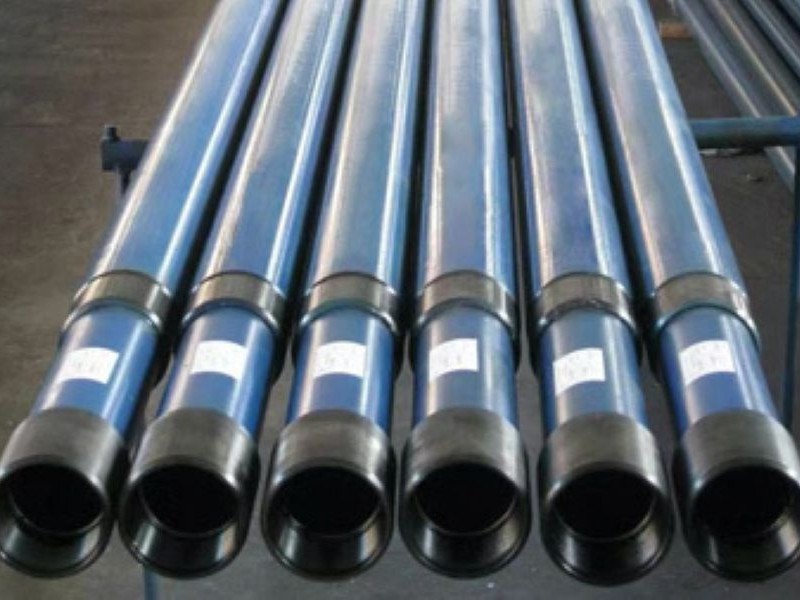Faults often occur in pumping wells during production. Oil production workers must promptly discover, analyze and determine the causes, take appropriate measures to eliminate the faults, observe the effects, and summarize experience during inspections to ensure normal production of oil wells.
I. Main causes of sucker rod pump failures:
The factors that usually affect the normal operation of sucker rod pumps underground are corrosion, liquid hammer, gas, sand, wax deposition and scaling, which are the main causes of sucker rod pump failures.
1. Corrosion:
Corrosion exists to varying degrees in oil wells, and corrosion is very harmful to all equipment underground. The main corrosive media in oil wells are hydrogen sulfide, carbon dioxide, oxygen, brine and corrosion caused by sulfuric acid-reducing bacteria.
(1) Common forms of corrosion of sucker rod pumps include brittle corrosion, acid corrosion, fracture corrosion, electrochemical corrosion, pitting corrosion and abrasion corrosion.
(2) The main measures to prevent and reduce corrosion of sucker rod pumps are to design and manufacture corrosion-resistant sucker rod pumps. The main parts of this pump, such as the pump barrel, plunger, valve ball and valve seat, are all made of materials with good corrosion resistance and wear resistance or are electroplated and heat-treated. The oil well should select the corresponding material of the sucker rod pump according to the corrosive medium in the well.
2. Liquid hammer: During the upstroke of the downhole sucker rod pump, when the pump chamber is not completely filled with liquid, a low-pressure gas cap will appear on the top of the pump chamber. Then, during the downstroke, the floating valve remains closed until the hydraulic pressure suddenly rises at the moment of contact with the liquid, and the valve is opened. This working condition is called "liquid hammer". "Liquid hammer" is very harmful to the entire pumping system.
(1) Causes of "liquid hammer":
① Due to insufficient submergence, the well fluid in the pump is not filled well, and the pumping conditions are not ideal, the "empty" phenomenon will occur, leading to the occurrence of "liquid hammer".
② Due to the partial blockage of the pump oil inlet hole, the dynamic liquid level rises, and the pump displacement decreases. At this time, "liquid hammer" will also occur.
(2) Hazards caused by "liquid hammer":
① "Liquid hammer" will increase the fatigue of the gears, bearings and other components or foundations of the pumping unit gearbox.
② "Liquid hammer" will increase the tensile fatigue of the sucker rod and the damage to the floating valve assembly of the sucker rod pump. It will also accelerate the damage of the valve stem, the rupture of the pump barrel and the failure of the fixed valve.
③ "Liquid hammer" will also cause the oil pipe thread to wear, leak or even break.
(3) Measures to reduce "liquid hammer":
① Establish a reasonable pumping unit working system and optimize the pumping parameters. Make the pump displacement compatible with the oil layer's fluid supply capacity so that the sucker rod pump efficiency is always at the high efficiency limit (at the best state, the pump effect reaches more than 80%).
② The speed of the motor or the motor pulley can be adjusted to make the pump displacement compatible with the oil layer's fluid supply capacity.
③ Use a pumping controller to start and stop the motor regularly to reduce the occurrence of "liquid hammer".
④ Master the liquid level recovery time and drop time, and automatically open and close the oil well to reduce "liquid hammer".
⑤ If the oil well pump inlet is confirmed to be blocked, the pump should be started and cleared in time.
3. Gas:
(1) Source of gas:
① Free gas from the well enters the pump.
② Gas generated by the separation of oil and gas at the pump inlet during the upstroke.
(2) Ways to reduce the impact of gas on the sucker rod pump:
① Increase the sinking depth to increase the pump inlet pressure.
② Install the sucker rod pump downhole air anchor and adjust the oil well working system to make the pump displacement adapt to the oil layer supply.
(3) Gas lock:
When the sucker rod pump cavity is filled with gas, the gas expands and compresses in the pump cavity during the upstroke and downstroke, the floating valve and the fixed valve lose their function, and the oil well cannot pump out liquid. This working condition is called "gas lock".
Minimize the anti-stroke distance of the sucker rod pump as much as possible to reduce the possibility of gas lock.
4. Sand:
Sand is one of the adverse factors that affect the operation and life of the sucker rod pump. Install sand guides, sand anchors, sand filter pipes, etc. For particularly serious sand production, anti-sand measures can be considered to reduce the impact of sand on the operation of the sucker rod pump.
5. Waxing:
When the pump itself is prone to waxing, an extended plunger pump or a movable rod pump with corresponding anti-waxing tools should be used, which is more conducive to the operation of the sucker rod pump.
6. Scaling:
Many oil wells contain various salts in the liquid. Once the physical and chemical conditions change, scaling will occur in a certain area of the oil well. Currently, chemical treatment methods are mostly used to reduce the occurrence of scaling.
(1) Scaling will cause the downhole casing perforation or the oil inlet hole of the gas anchor to be blocked, causing the oil well to produce "liquid hammer" phenomenon.
(2) Scaling will cause the sucker rod pump parts or holes to be blocked, making the pump unable to work normally.
(3) Use an extended plunger pump to ensure that a section of the plunger rushes out of the upper end of the pump barrel in each stroke, thereby avoiding the occurrence of plunger jamming due to scaling.

II. Methods for Diagnosing Pumping Unit Failures:
1. Dynamometer Diagram Method:
The dynamometer diagram is currently an effective method for checking the operating status of deep-well pumps. Analysis of the dynamometer diagram can determine the effects of sand, wax, and gas on deep-well pumps. It can identify faults such as pump leakage, tubing leakage, sucker rod breakage, piston-to-mandrel fit, and piston sticking. The dynamometer diagram must be combined with data accumulated during routine well management (such as well production, dynamic fluid level, sand level, sand content, current changes during pumping unit operation, and the service life of downhole equipment) for comprehensive analysis.
2. Pump Test Method:
This method involves pumping liquid into the tubing and diagnosing sucker rod pump failures based on changes in pump pressure. There are two pump test methods: One method involves placing the piston in the mandrel for a test pump. If the pump pressure drops or is absent, it indicates leakage in both the suction and discharge sections of the pump. The other method involves removing the piston from the mandrel and pumping liquid for a test pump. If there is no pressure or the pressure fails to rise, it indicates severe leakage in the suction section.
3. Wellhead breathing observation method:
This method is to close the wellhead back pressure gate and the connecting gate, open the vent gate, and block the vent gate outlet with your hand. You can also cover the vent with a thin piece of paper. In this way, you can judge the pump failure by feeling it with your hand or observing the movement of the paper, that is, observing the up and down "breathing" of the sucker rod pump. Generally, the following faults can be judged:
(1) The oil well does not produce oil and it emits air when it goes up and inhales air when it goes down. This indicates that the fixed valve is seriously leaking or the oil inlet is blocked.
(2) The oil well does not produce oil and it emits air slightly when it goes up, and then inhales air again. This indicates that the main floating valve is leaking.
(3) There is a lot of air when it goes up and a little when it goes down. This phenomenon indicates that the sucker rod pump is working normally, but the liquid level in the oil pipe is low and the oil has not been pumped to the wellhead.
4. Wellhead pressure holding method:
The pressure holding method is to analyze and judge the working condition of the sucker rod pump, oil pipe leakage, etc. by the two situations of pumping and stopping. This method is currently widely used in oil fields. The specific operation method is: close the back pressure gate and the connecting gate during the operation of the pumping unit, and then observe the changes in the oil pipe pressure at the wellhead (the maximum pressure is 2.5MPa). The pressure rise can be used to analyze and judge the downhole fault, which is called pumping and holding (it should be noted that when the pressure exceeds 2.5MPa, the back pressure gate must be opened immediately); when the pumping pressure reaches 2.5MPa, stop pumping, and then hold for 10~15 minutes, and observe the pressure drop, which is called stopping and holding. If the pressure remains unchanged or drops slightly, it means there is no leakage; if the pressure drops faster, the leakage is more serious.
(1) The pressure rises faster during the upstroke and remains unchanged or rises slightly during the downstroke, indicating that the pump is in good working condition.
(2) The pressure rises faster during the upstroke and drops during the downstroke. After pumping for several minutes, the pressure change range remains unchanged. This situation indicates that the floating valve is always closed and cannot be opened, indicating that oil is not entering the pump. The reasons are as follows: ① The fixed valve is seriously leaking or completely failing; ② The oil inlet of the pump is blocked; ③ The gas has a great impact, causing gas lock; ④ The liquid level is very low and the pump does not supply oil. The specific reason needs to be comprehensively analyzed and judged in combination with other data, such as dynamic liquid level data, casing gas size, production, sand production and sand surface, and wax deposition data.
(3) The pressure rises slowly or does not rise during the upstroke, and the pressure remains unchanged during the downstroke, indicating that the discharge part is leaking (it may be a leak in the floating valve, oil pipe, or the gap between the piston and the bushing).
(4) The pressure rises quickly during the upstroke and drops slowly during the downstroke, indicating that the fixed valve is leaking, but not seriously. The faster the pressure drops during the downstroke, the more serious the fixed valve leakage.
(5) The pressure rises quickly during the upstroke, drops at the beginning of the downstroke, and then becomes basically stable, indicating insufficient fluid supply.
(6) The pressure does not rise during the upstroke and drops during the downstroke, indicating that both valves have serious leakage.
We will stop here for this article. In the next article, we will explain in detail how to troubleshoot common faults in pumping wells and the analysis steps for abnormal wells. Friends who are interested can click to jump and read!

